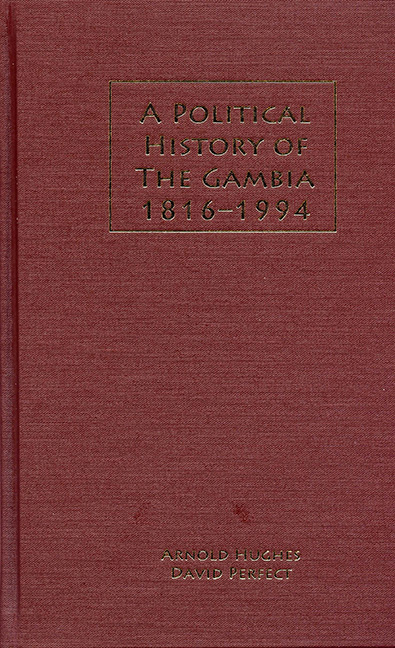Book contents
- Frontmatter
- Dedication
- Map
- Contents
- List of Tables
- List of Interviewees
- Acknowledgments
- Abbreviations
- Introduction
- 1 Social and Economic Setting
- 2 Constitutional Change in The Gambia, 1816–1994
- 3 Merchants and Recaptives: The Origins of Modern Politics, 1816–86
- 4 Patrician Politics in the Era of the Forsters, 1886–1941
- 5 The Establishment of Party Politics, 1941–59
- 6 The “Green Uprising”: The Emergence of the People's Progressive Party, 1959–65
- 7 Electoral Politics, 1965–81
- 8 Radical and Insurrectionary Political Challenges, 1965–81
- 9 Electoral Politics, 1981–94
- 10 The Gambia's External Relations, 1965–94
- 11 The 1994 Coup and the Jawara Legacy
- Appendix A Major Constitutional Changes, 1816–1994
- Appendix B Legislative Council Election Results, 1947–54
- Appendix C General Election and By-Election Results, 1960–93
- Appendix D Presidential Election Results, 1982–92
- Appendix E Republic Referendum Results, 1970
- Appendix F Primary Sources
- Appendix G Newspapers and Magazines Consulted
- Notes
- Bibliography
- Index
- Rochester Studies in African History and the Diasora
8 - Radical and Insurrectionary Political Challenges, 1965–81
Published online by Cambridge University Press: 13 April 2017
- Frontmatter
- Dedication
- Map
- Contents
- List of Tables
- List of Interviewees
- Acknowledgments
- Abbreviations
- Introduction
- 1 Social and Economic Setting
- 2 Constitutional Change in The Gambia, 1816–1994
- 3 Merchants and Recaptives: The Origins of Modern Politics, 1816–86
- 4 Patrician Politics in the Era of the Forsters, 1886–1941
- 5 The Establishment of Party Politics, 1941–59
- 6 The “Green Uprising”: The Emergence of the People's Progressive Party, 1959–65
- 7 Electoral Politics, 1965–81
- 8 Radical and Insurrectionary Political Challenges, 1965–81
- 9 Electoral Politics, 1981–94
- 10 The Gambia's External Relations, 1965–94
- 11 The 1994 Coup and the Jawara Legacy
- Appendix A Major Constitutional Changes, 1816–1994
- Appendix B Legislative Council Election Results, 1947–54
- Appendix C General Election and By-Election Results, 1960–93
- Appendix D Presidential Election Results, 1982–92
- Appendix E Republic Referendum Results, 1970
- Appendix F Primary Sources
- Appendix G Newspapers and Magazines Consulted
- Notes
- Bibliography
- Index
- Rochester Studies in African History and the Diasora
Summary
As Chapter 7 showed, the People's Progressive Party (PPP) successfully maintained its political hegemony in the first fifteen years after independence, despite severe internal divisions and the emergence of the National Convention Party (NCP) in the mid-1970s. Yet its position remained insecure. The longer it stayed in power, the more it suffered from political sclerosis with its attendant neglect of important sections of the political community.
President Jawara also came to be seen as tolerating a persistent and growing incidence of cronyism and downright corruption on the part of his ministers and senior civil servants identified with the PPP administration. Even when it became necessary to remove such transgressors, the almost ritualistic process, which usually avoided any legal investigation or penalty, came to be his political Achilles’ heel and contributed to the undermining of his legitimacy in radical political circles. Jawara's own personal finances also came under suspicion. In addition, his “one nation” approach, involving the creation of patron–client networks to link the political centre with its periphery, came with a price. Although it had clearly helped The Gambia avoid the intercommunal strife that wracked so many other African states after independence, the system was denounced by his radical critics.
The first wave of post-independence dissidents were won over with scholarships and accelerated promotions. But a second wave came close to overthrowing The Gambia's democratic political system by violent means in 1981. The Gambian coup was unusual in sub-Saharan Africa, where coups were then commonplace, in being organized and led by disaffected civilians rather than by soldiers, although the support of disaffected members of the paramilitary Field Force was crucial to the success of the operation. The coup, which resulted in several hundred deaths, was eventually defeated after the intervention of Senegalese forces.
Ideological and Economic Dimensions of Radical Political Opposition
Radical political dissent in The Gambia after independence centered principally on urban youths, whose opposition to the status quo rested on a mixture of ideological idealism and personal frustration (although, as indicated below, the opportunities for career advancement were in practice much greater for this group than for the second wave of dissidents).
- Type
- Chapter
- Information
- A Political History of the Gambia, 1816–1994 , pp. 198 - 220Publisher: Boydell & BrewerPrint publication year: 2006

